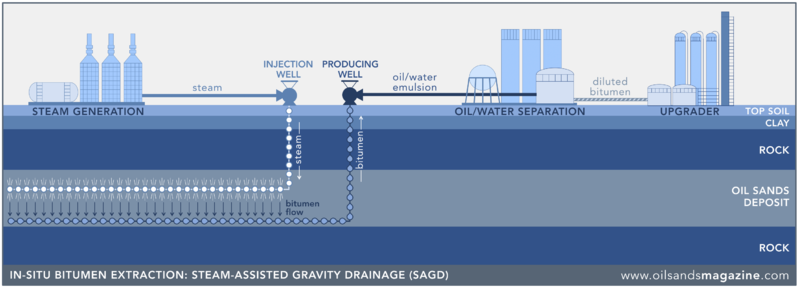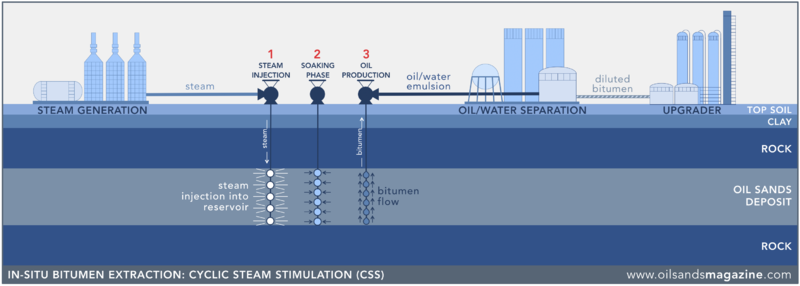In situ oil sands mining
Oil sands deposits that are greater than 75 meters below the ground surface are usually extracted without removing the overlying rock and dirt. This is known as in situ oil sands mining.[1] Oil sands deposits are usually split into two types of deposits. Shallow deposits are located within approximately 75 meters of the ground surface and are extracted using surface mining methods. Deep deposits are located at least 75 meters below surface level.
The fossil fuel being mined in oil sands deposits is bitumen which is a type of low-quality crude oil. Bitumen is used to make synthetic crude oil. Crude oil is important to make various products like gasoline, kerosene, and plastic. In Alberta alone, 80% (or 135 billion barrels) of the oil sands are located in these underground deposits and specific techniques such as SAGD are necessary to access these deposits.[1]
The formation of oil sands is slightly different than the formation of a conventional oil deposit. Like all oil, the bitumen in the oil sands formed from an accumulation of organic material that was buried under sediment. Over millions of years the heat and pressure on this matter increased, causing bacteria to break it down in an oxygen-poor environment. At this point, instead of dispersing throughout the geological formation, the fossil fuel adheres onto sand grains, creating oil sand deposits. Within the oil sands are fine clay particles, along with other minerals such as assorted metals and sulfur.[1]
Extraction Methods

There are several different methods to extract bitumen from in situ deposits. Regardless of what type of extraction method is used, it must be able to reduce the viscosity of the bitumen so that it can freely flow and it must provide some way of recovering the bitumen from the deposit (Figure 1). Generally, the three methods that can be used to reduce the viscosity of the bitumen are the addition of steam, solvents, or thermal energy.[3]
The one of the most common methods used for in situ recovery is steam assisted gravity drainage (Figure 2). Two wells are drilled, approximately 5 m apart. Steam injected into the top well causes the bitumen to become fluid enough that it flows into the other well and can be pumped out of the ground. [4] Two benefits of this method of extraction exhibits is that tailings ponds are not a necessity as sand remains in the ground and less water is used to create the oil. One barrel of crude oil in its synthetic form only requires half a barrel of water.[3]

The other common method is cyclic steam stimulation (Figure 3). A single well is drilled and used to inject steam into the bitumen deposit. The steam is kept under high pressure for multiple days to weeks, allowing the reservoir soak up the steam to make the bitumen more fluid. The bitumen/steam mix is then pumped up the same well to the surface.[4]

Steam assisted gravity drainage and cyclic steam stimulation are not the only ways to extract bitumen from underground deposits, but they are the most widely used. Other options include Toe-to-Heel Air Injection, Vapour Extraction Process, and an Electro-Thermal Dynamic Stripping Process. For more information on these new alternatives to steam assisted gravity drainage, see here.
Environmental Impacts
One of the biggest benefits of utilizing in situ mining techniques is that there are no tailings ponds required, as the sand remains in the ground with only bitumen extracted. However, the amount of water used can be an issue (even if it's less than conventional oil extraction), with one barrel of synthetic crude oil requiring half a barrel of water for its extraction.[3] Although up to 90% of the water used during extraction is recycled and used again,[5] there is still some water disposal that occurs. This water can be fresh or brackish,[5] and may contain a variety of pollutants. Depending on how this water is disposed of, it could contaminate clean groundwater deposits or harm plant and animal life around the deposit. In addition, the volume of water used is an issue because there are concerns with how much water residential areas need and how much is being taken from mutual sources for in situ use.
Emissions are also an issue when it comes to anything involving the production of fossil fuels. The emissions of carbon dioxide for bitumen development and pre-processing are about 110 kg per barrel—three times the amount for a barrel of crude oil.[6] The in situ extraction operations account for about half of this—around 60 kilograms of carbon dioxide per barrel of bitumen.[3] The consumption of natural gas to produce the steam used in these operations is considered to be an issue as it releases emissions associated with natural gas. These emissions can range from carbon dioxide to carbon monoxide and sulfur compounds depending on the purity of the gas.
For Further Reading
- In situ
- Oil sands
- Bitumen
- Steam assisted gravity drainage
- Pollutant
- Formation of a conventional oil deposit
- Or explore a random page
References
- ↑ 1.0 1.1 1.2 Natural Resources Canada. (Feb.19, 2016). Oil Sands Extraction and Processing [Online]. Available: https://www.nrcan.gc.ca/energy/oil-sands/18094
- ↑ 2.0 2.1 2.2 Oil Sands Magazine. (Oct.22, 2018). In-Situ Bitumen Extraction [Online]. Available: https://www.oilsandsmagazine.com/technical/in-situ
- ↑ 3.0 3.1 3.2 3.3 Pembina. (Accessed Oct.20, 2018). Mining vs In-situ [Online]. Available: https://www.pembina.org/reports/mining-vs-in-situ.pdf
- ↑ 4.0 4.1 Jiang Q, Thornton B, Russel-Houston J, Spence S. Review of thermal recovery technologies for the clearwater and lower grand rapids formations in the cold lake area in Alberta. Journal of Canadian Petroleum Technology. 2010 Sep 1;49(09):2-13.
- ↑ 5.0 5.1 Natural Resources Canada. " Water Management in oil sands". (Dec.15, 2015). Available from: https://www.nrcan.gc.ca/energy/oil-sands/water-management/5865
- ↑ US Department of Energy, National Energy Technology Laboratory "An Evaluation of the Extraction, Transport and Refining of Imported Crude Oils and the Impact on Life Cycle Greenhouse Gas Emissions", March 27th 2009. DOE/NETL-2009/1362 available online: http://www.netl.doe.gov/File%20Library/Research/Energy%20Analysis/Publications/DOE-NETL-2009-1362-EvalExtTransRef-ImportCrudeOils-ImpactLCGHGEmis.pdf accessed June 22nd, 2015.

